Menu
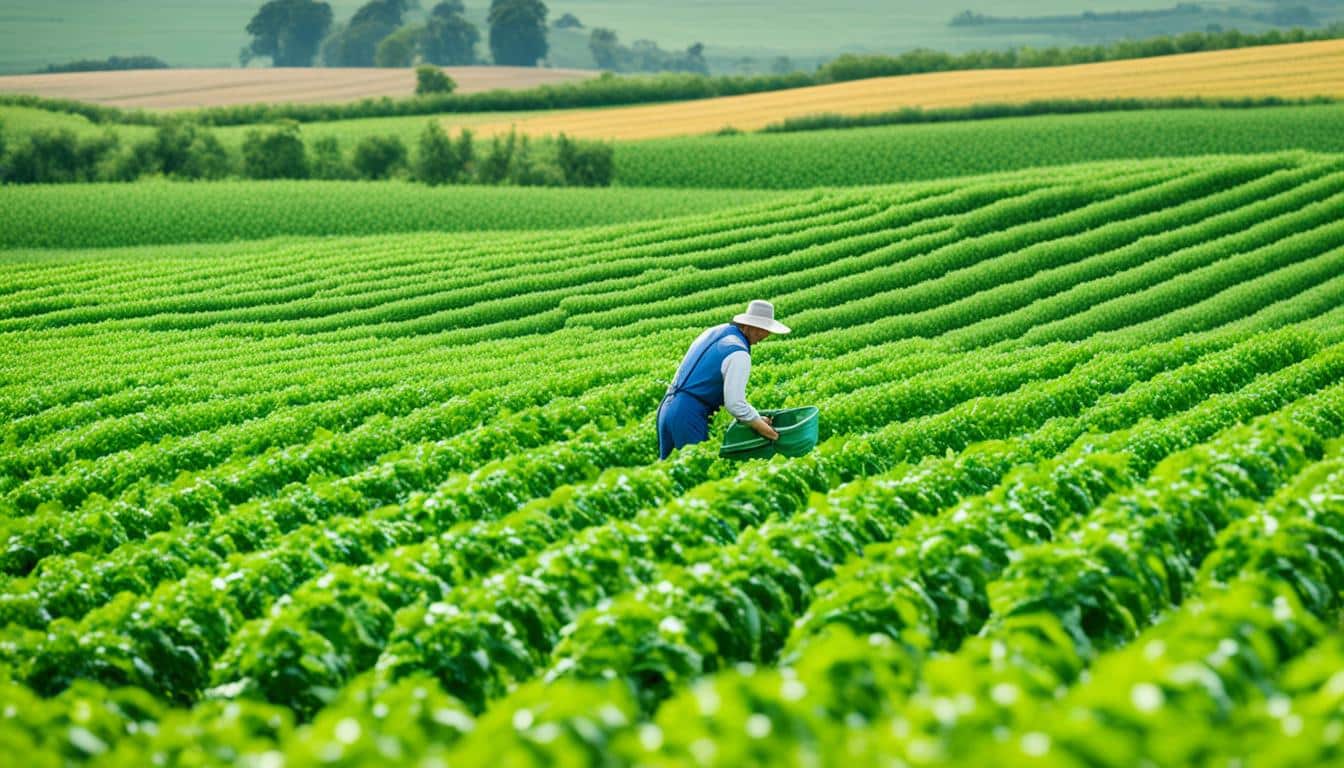
Over 30% of the world’s arable land has been lost to soil degradation in 40 years. This alarming trend highlights the need for sustainable farming. It is crucial for our climate, nature, and the livelihoods of farmers. At the European Parliament, an event on 21 September 2023 discussed these challenges.
The European Council of Young Farmers (CEJA) and other key groups spoke at the event. They talked about the urgent need for change in agriculture. The sector faces big challenges like climate change and financial problems for farmers.
Many experts agree that a holistic approach to farming is the way forward. Big companies like Danone and Nestlé are aiming for regenerative farming. This approach is good for the earth and the farmers. However, young farmers like Elisabeth Hidén face hurdles in this journey.
Hidén, from CEJA, points to obstacles such as climate change and getting access to land and funds. These challenges are especially tough for new farmers.
Elze Jellema from FrieslandCampina also stressed the need to work more closely with farmers. He talked about setting up systems to reward farmers for protecting the climate and biodiversity. Such incentives are key, as discussed at the event.
Stefania Avanzini from One Planet Business for Biodiversity (OP2B) is hopeful. She believes that moving towards regenerative farming is possible on a big scale. This belief is shared by many, making this a key time for change in farming.
For more details on the event, refer to Scaling up and de-risking the sustainable transition in agriculture.
Sustainable farming is key to tackling today’s farming issues. It boosts farmers’ strength, helps the environment, and fights climate change. Big names like Danone and Nestlé back these methods. They see how it helps both farmers and the planet.
These green farming ways bring many good points. They lower risks from changing weather and boost how well farmers can handle tough climate events. For our climate, they help cut the carbon footprint. Plus, methods like growing trees with crops and switching what is grown where save water and soil. This keeps the land working well for longer.
“Transitioning to sustainable agriculture is not a choice but a necessity for the resilience of our food systems.” – Stefania Avanzini, OP2B Director
Good farming ways also mean nature thrives. By using natural pest control and cutting back on man-made chemicals, we make healthier homes for plants and animals. This way of farming also fits with taking care of the environment, making sure we save resources for those coming after us.
Today, farming has big problems like not enough clean water and tired soil. It’s also hard for small farms to survive. Places like California are facing dry spells and too little groundwater because of bad water use.
To overcome these hurdles, sustainable methods offer hope. Using crops that don’t need as much water and smart irrigation are crucial. It’s also important to deal with water pollution from farm chemicals and fertilisers for nature’s sake.
We also need to help family farms survive and make farming more affordable. Working together and finding new ways to help farmers can push sustainable farming forward. This is how we build a stronger, long-lasting farming future for everyone.
Agricultural sustainability means farming in a way that takes care of the earth without harming it. It also looks at how to earn money without causing damage. By using these methods, farmers protect the land and help it stay healthy. This allows them to keep making a living for a long time.

Sustainable farming avoids using up important natural resources. It’s about keeping the soil, water, and crops healthy. It’s been known that if we don’t farm in the right way, like in ancient times, the land can become less fruitful. The lessons from the past teach us to use smart farming methods. These help us not just survive but thrive.
Looking after the environment is key in farming. This becomes even more critical in places hit hard by climates like droughts. For example, in California, farmers are working to use less water by conserving more and storing it better. They’re also encouraged to grow plants that can survive with less water. There’s a focus on using water wisely to avoid harming crops with too much salt. These efforts help farmers face tough situations and keep the land producing good food.
Being efficient in growing crops is key to making farming sustainable. This approach helps produce food in a way that is gentle to the earth. By using advanced farming methods, we can grow more food with less harm to our planet. This is really important in the face of today’s farming challenges.
Sustainable farming aims to get the most crop without using up or hurting nature. Ways like no-till farming stop the ground from washing away and getting too hard. They cut down on releasing gases that harm our air, and they make things easier for farmers, too.
Plus, planting cover crops keeps the soil healthy, stops it from moving, and helps bees. Drip irrigation uses less water than the old ways, which is a big win for sustainable farming. It means keeping water around for longer, a major part of saving the environment while growing food.
In today’s green agriculture, we can’t do without tech. Using data to farm smartly helps save resources and grow better crops. Knowing about the soil, saving water, and using nutrients the right way are all thanks to technology.
The more we learn, the more our farming can be friendly to nature. By combining new tech with what we knew before, we cut down on harmful chemicals. We save water and keep more plants and animals around. This is how we make food that’s good for the earth and the people who eat it.
Sustainable farming is all about looking ahead, without forgetting about the future. It’s about being careful with what we have, so there’s enough for everyone later on. Doing this builds strong farms that can handle whatever comes their way. It’s only by working together, sharing what we know, learning, and making rules that we can make sure our farms are green and successful for years to come.
Scaling sustainable farming is not easy. It faces many challenges. These must be solved for agriculture to be sustainable long term. The need for land and money is especially critical. This point is often made by experts and farmers.
Farmers struggle to get the land they need for sustainable methods. Young farmers find it hard to get enough land. The cost to switch to sustainable ways is also high. This makes it even more difficult. We use a lot of land to grow food. But, with the demand for food set to increase, the rush to use sustainable methods grows.
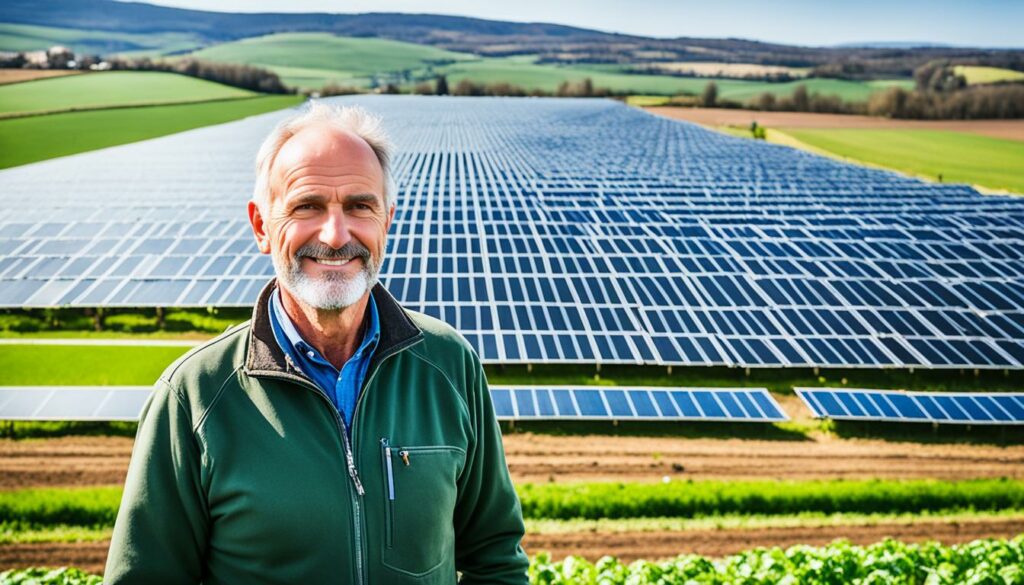
Add to this the fact that the agriculture chain is not well-linked. This makes it hard to pass on benefits from eco-farming to farmers. We need better incentives so farmers see the value in new, greener ways. Without these, farmers don’t see the reason to try something new.
Climate change is hitting agriculture hard. Soil is getting worse, water is scarce, and the weather is unpredictable. All these things affect how we farm to take care of the environment. The unpredictability of weather makes farming more expensive and risky for farmers.
In places like Malawi, people are slow to try new farming techniques. They fear losing crops, the high cost to change, and the lack of insurance for those risks. Plus, it costs more to hire workers, but fewer people want to live in rural areas. This makes the situation worse. That’s why working with groups that research and innovate is key. They help introduce technologies that make farming smarter against climate change.
| Challenge | Impact |
|---|---|
| Access to Land | Consolidation of arable land is difficult for young farmers |
| Funding | High financial burdens for transitioning to sustainable practices |
| Climate Change | Increased weather volatility affecting productivity |
| Technological Adoption | Limited access and high costs hinder technology implementation |
| Incentives | Disparate programmes prevent uniform benefit distribution |
We need to tackle all these tough issues together. This requires new funding, more training, and working closely with everyone in the agriculture chain. Making sustainable farming a better choice for everyone is very important. It prepares us for feeding the growing global population sustainably.
Agriculture is changing fast due to new innovations. It’s becoming crucial to farm in ways that are good for the planet. These changes are real, making farming more eco-friendly all around the world.
Sustainable investment has reached $35.3 trillion globally from 2018 to 2020. This shows a big push towards being more sustainable and innovative in agriculture.
Precision farming is leading the way. With GPS-guided machinery, drones, and sensors, crops can be managed very closely. This boosts efficiency and plants the seed for more sustainable farming.
John Deere’s work in this field has been awarded at the CES Innovation Awards. Their technologies like ExactShot and See and Spray Ultimate are reducing waste and harm to the environment.
A shift in financial supports is also happening. Sustainable Bonds and loans are offering good deals to green companies. This makes it easier for these companies to get funding.
New financial tools in agriculture, like Supply Chain Finance, are showing promise. By 2020, Supply Chain Finance was worth $1.3 trillion. This hints at a future with even more eco-friendly farming.
Soil health monitoring is also getting a high-tech upgrade. Tools like soil sensors and satellite images help farmers know their soil better. This allows for smarter actions to keep the soil healthy, which is key for sustainable farming.
AgriTech startups are making big moves too. They use AI, IoT, and blockchain to improve crop growth and use resources smartly. With more than 200 apps for crop management available, farmers have plenty of help at their fingertips.
Big names like John Deere and initiatives like Engaged Acres are aiming for huge sustainability goals by 2030. Thanks to their work, farmers can take on big challenges with new confidence.
The future of farming relies on tech, new financial supports, and working together. This mix is what will protect our planet and keep farming going strong.
Public-private partnerships (PPPs) are key in promoting sustainable farming worldwide. They bring together governments, non-profits, and private firms. This collective teamwork overcomes challenges in farming, boosts innovation, and helps farmers be more productive.

PPPs shine at gathering different skills and resources for agriculture. They introduce new farming technology to make agriculture more eco-friendly. This helps farmers manage their farms better. By working together, those involved keep improving methods and adapting new technologies.
Big companies are crucial in making PPPs work. For example, Elze Jellema from FrieslandCampina mentions rewarding successes helps a lot. With the government and schools on board, these businesses help make farming greener. They also push for laws that help farming become more sustainable. PPPs are essential in gathering funds and support for their work.
| Initiative | Impact |
|---|---|
| Initiative 20×20 | 150 partners, $2.5 billion private capital, 50 million hectares protected/restored |
| Power Africa | 37.5 million new connections, 14,000 megawatts of clean energy projects in sub-Saharan Africa |
| Breathe London | Improving air quality in London via a 4P model pilot funded by the Clean Air Fund |
Using sustainable agriculture in farm management is key to long-lasting agriculture success. Holistic farm management combines various sustainable methods. It enhances the link between farming, the environment, and local communities.
Agroecological practices are great for meeting climate, biodiversity, and food goals. In Scotland, a study highlighted five key approaches. These were regenerative agriculture, integrated farm management, organic farming, agroforestry, and low-input farming.
Regenerative agriculture and organic farming showed they could adapt to many places. They also help farmers save money by using fewer resources. Agroforestry and integrated farm management can match usual farming’s output. But, they showed slightly lower yields than other agroecological methods. However, they bring more profit thanks to lower costs. Shifting to these practices requires money. Strategies like labelling or certification can add value to their produce, making this transition easier.
There are real successes in using holistic farm management. Tracy Litle enhanced soil and ground cover with holistic methods. She also improved her life balance. She proved these practices work. Another study found lower yielding methods can actually bring in more money.
People from different careers found learning holistic farming valuable. Joining groups like Holistic Management International has benefits. These include learning to listen well and solve problems. Such support improves their work in farming.
These studies show how holistic farm management can do more than just sustain agriculture. It shows it can be economically smart and promote a strong future for farming. Adopting these practices takes skill and dedication. But, it pays off well when done right.
Organic farming is getting a lot of attention because it has great benefits for the environment and our health. Yet, making organic farming bigger faces many tough challenges. Getting into more markets and finding new ways to finance growth are just two hurdles to cross.

Organic farming stands out for many reasons. It helps grow crops well, keeping the environment in balance over the long term. By focusing on looking after the soil with techniques like crop rotations, organic farms do better than traditional ones. This success is backed by a $57 billion-a-year market, showing more and more people want organic food.
To make organic farming bigger, some key strategies work well:
Working on these points will help us create a larger, more sustainable organic farming scene. This way, more people can enjoy the benefits of organic foods, all while keeping to the high standards of organic farming.
It’s key to fund sustainable farming to make these efforts grow. Many new money methods and ways to decrease risk help a lot. They make it easier for farmers to use smart and earth-friendly farming ways.
The FSA Microloan Program is an example that works well. Started in 2013, it has given $570 million to new, minority, and small farm owners big help. Over 25,000 farmers from nearly all states have got loans up to $50,000. They can get up to $100,000 in loans for running their farm or buying it.
Congress keeps putting money into direct loans for farm work and buying farms. A big part goes to FSA microloans, like over $161 million of the recent $3 billion. This shows the increasing interest in backing sustainable farming.
Banks too are stepping up with special farm loan departments. They offer different kinds of loans. These include credit lines and loans for short to long-term needs. They help with daily farm costs or big projects like buying land.
Making farming investment less risky is important to grow sustainable farming. The Farm Credit System helps with various loans and advice. This is a big help, especially for new and small farmers who find it hard to get regular loans.
The Farm Service Agency (FSA) gives loans using federal funds. It aims at those new to borrowing and with little wealth. Using FSA increases the chance of getting a loan. They often have better terms than regular banks.
A solid business plan and financial records are a must. Starting small and doing well with that loan can lead to getting larger loans. It’s a smart way to go about it.
The USDA’s FSA provides big loans up to $600,000 for buying farms and $400,000 to run them. They also help with up to $500,000 for storage and $100,000 for transport. These are key for many farmers.
“Innovative financial mechanisms and de-risking strategies are crucial for scaling sustainable farming. They provide vital support for farmers transitioning to climate-smart practices, ensuring both economic viability and environmental stewardship.” — Anonymous Agriculture Expert
Technology has changed how we make food. Before, many people worked in food production. Yet, today’s sustainable food production technology needs less human work. This shift is vital. Studies show that by using fewer inputs in farming, we could still get good yields. This is important for the future of farming.
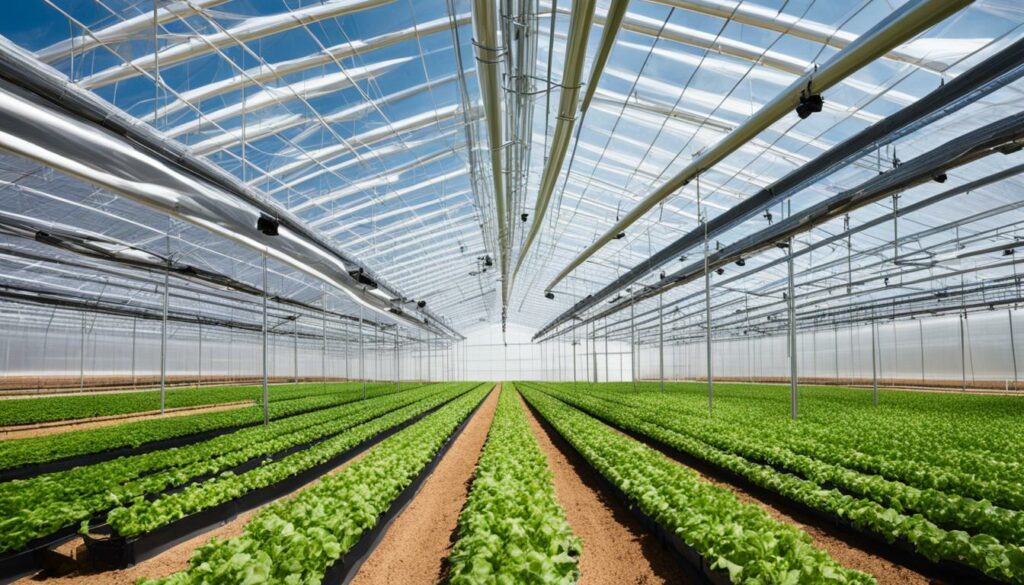
Precision farming leads in making food sustainably. It uses technology like GPS devices and remote sensors to manage crops better. With this tech, we can make sure each plant gets the right amount of water and nutrients. This cuts waste and boosts the food we grow. It’s a smart way to meet food needs without hurting the planet.
Data in farming plays a huge role these days. Farmers can track crop health and soil moisture in real-time. This helps them make better choices. The use of tech in farming has already upped food production while needing less work. Now, tech and data are key to farm more efficiently and with less harm to the environment.
With the right sustainable food production technology, we could farm more on less land. Without these high-tech methods, we might need as much space as South and North America combined. Using these technologies is not just a good idea; it’s crucial for the future of food.
| Key Technology | Benefits |
|---|---|
| Precision Agriculture | Optimises resource use and reduces waste, potentially revolutionizing crop management |
| Remote Sensing | Enhances ability to monitor and manage crop health in real-time |
| Data Utilisation | Supports informed, data-driven decision-making, improving sustainability |
Using resources wisely is key in farming for the future. It ensures that current needs are met without harming future chances. Sustainable farming has grown over time, blending green health with making money and fair play.
Water, a key resource, is vital in farming. Conserving it is essential to keep crops growing and use resources well. Techniques like drip irrigation and collecting rainwater help save water. This also lowers the chance of salty soil and dirty water.
Looking after the soil is a must for any farm aiming to last. Things like planting different crops each season and planting cover crops help keep soil healthy. These methods make the soil stronger, richer, and able to keep growing crops.
| Technique | Benefits |
|---|---|
| Crop Rotation | Improves soil nutrients, breaks pest cycles |
| Cover Cropping | Enhances soil structure, prevents erosion |
| Drip Irrigation | Minimises water loss, targets root zones |
| Rainwater Harvesting | Supplies additional water sources, reduces demand on freshwater |
Farming smarter isn’t just about new tech. It’s about mixing new ideas with old wisdom to save water and soil. Doing this helps agriculture last without harming the planet or those depending on it.
Scaling sustainable farming takes a team effort from farmers, agribusinesses, and policymakers. In September 2023, the European Parliament focused on this. They pointed out big companies’ efforts like Danone, Unilever, Nestlé, and McCain in switching to regenerative farming. A new farmer from Sweden, Elisabeth Hidén, highlighted the issues like climate change, getting land, and funding for young farmers. These are the key things pushing for change.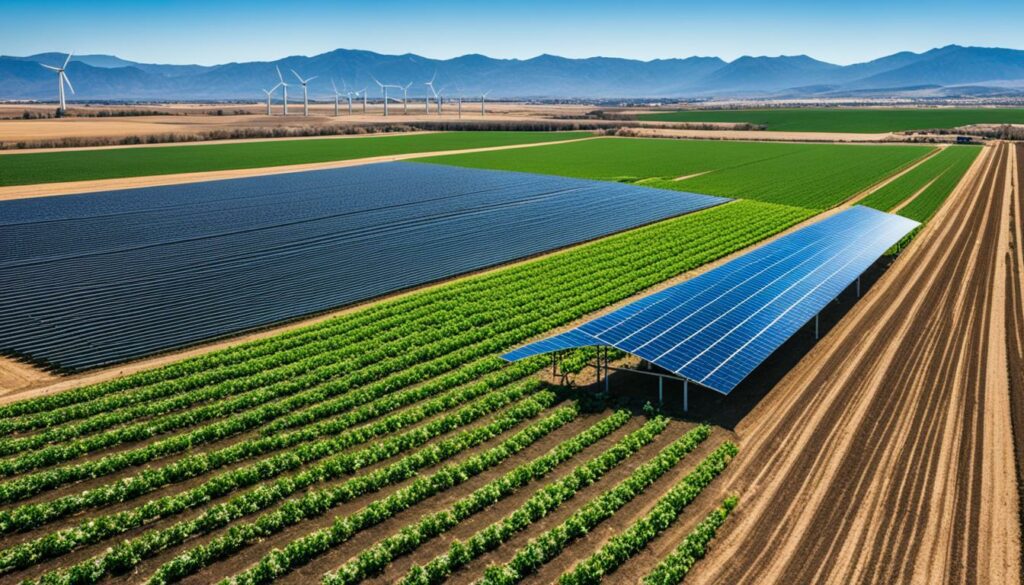
Just using public funds might not be enough to change agriculture. So, new financial strategies are needed. With food demand set to grow 40% by 2050, thanks to more people and different diets, it’s vital to increase sustainable farming. Otherwise, we’ll have to clear new land bigger than South America, which would harm our environment.
There are new, eco-friendly ways to produce food, thanks to science. These include cover crops and precision farming. It’s essential for farmers, food companies, and those who care about the environment to work together. They help encourage the use of sustainable farming. Elze Jellema talks about working with farmers. She suggests making plans to protect climate and biodiversity. Stefania Avanzini from OP2B believes the move to resilient agricultural models will be successful.
A report from 2022 showed that most U.S. row-crop farmers care more about making money than using conservation farming. Many haven’t thought about how conservation practices can benefit their wallets. Moreover, most of them aren’t part of private programmes that focus on making supply chains more sustainable. This shows a big chance exists to grow sustainable farming through better economic rewards and training.
| Statistic | Data |
|---|---|
| % Increase in Food Demand by 2050 | 40% |
| Potential New Farmland Area Needed | Larger than South America |
| Surveyed U.S. Row-Crop Producers (2022) | 500 |
| % Selecting Profitability as Key Performance Indicator | 76% |
| % Never Calculated Economic Benefits of Conservation | 59% |
| % Not Involved in Supply Chain Sustainability Programme | 88% |
Young farmers play a big role in making farming more sustainable. We need to back them up with plans that look at both making money and taking care of our planet. In the end, there’s an urgent need to do more about scaling sustainable farming. Teamwork and new ways to handle money are key to making this happen.
Government help and rewards are key to grow agriculture sustainably. Good farm policies connect what’s happening now to using better, greener ways. They are crucial in helping farmers move towards methods that are easier on the earth.
Government programs that aid farmers are vital for farming’s future. They help farmers take better care of the environment and give them funds to improve. The Food and Agriculture Organization highlights the need to work closely with each other to make agriculture greener, especially when fighting climate change.
Using public money is important for making this switch happen. It supports the good things everyone uses while helping businesses grow. These supports, like sharing risk and working together, are key for new ideas and greener farming. But, the help governments give differs a lot, from just a little to over half of what farms earn, based on where you are.
To grow agriculture in a way that lasts, we need certain policies in place. Pushing for sustainable food and farming that meets global goals can make a big difference. For this to work, we need solid plans and better ways to manage how farms run.
We should also set up rules that help everyone in farming, not just those producing things. These rules should not make it hard for farmers to change the way they work. Import taxes and changing help for buying farm stuff can slow down important farming changes.
And, helping groups of farmers join together can spread good ideas faster. By making smart policy choices, governments can help farming not just now, but for a long time, making farms stronger and more resistant to problems.
The future of farming and sustainability is closely tied to new trends and tech. Looking ahead, key areas will shape the field.
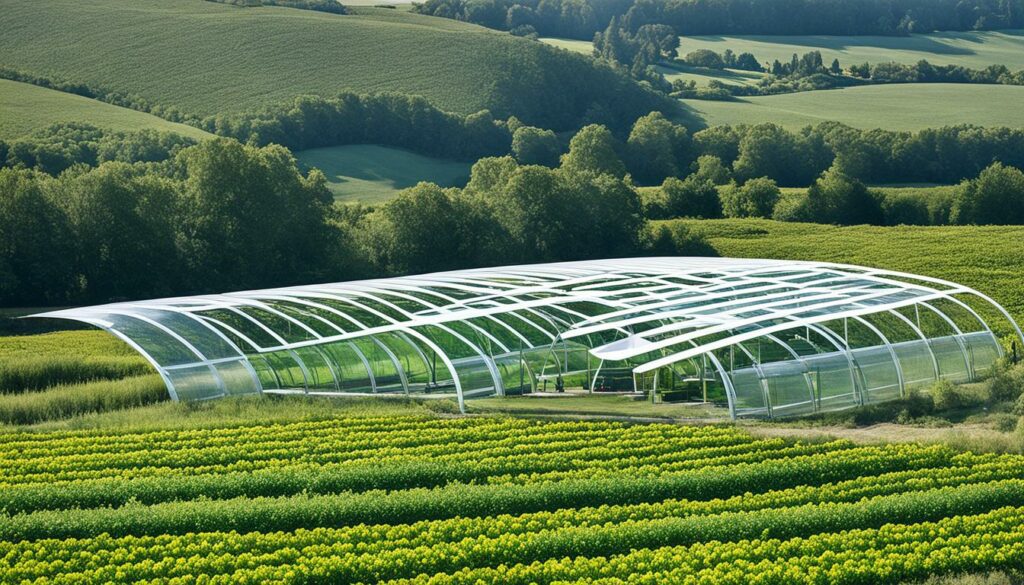
Farmers are turning to new tech to tackle climate change and feed more people. Things like GPS for precision and sensors to check soil are making farming smarter. They help cut down on waste and run more efficiently. Also, using solar, wind, and bioenergy means farming is less reliant on harmful fossil fuels.
Robots and AI are starting to do some of the hard work on farms. This isn’t just about being more efficient. It’s also key to making sure there’s enough food in the future. Additionally, science is improving plants so they can handle tough weather better, making farming more resilient.
In sustainable farming’s future, there are big goals to tackle. Farming needs to be tough against natural challenges. Using practices that help the land and its biodiversity thrive is a big part of this.
Another key goal is to farm in ways that don’t harm the planet. Agriculture’s impact on global warming and deforestation is significant. By cutting down on greenhouse gases and using less water, farming can be kinder to the earth.
These goals also aim to make sure everyone has enough to eat. The smaller number of farms today can be changed by more sustainable practices. This change could help millions who struggle to get food.
Creating the right environment for farming innovation is crucial. New farming trends point us towards a brighter future. This future aims to satisfy current needs while securing farming for the coming generations.
Since World War II, agriculture has seen major growth. This growth is thanks to new technology, more machines, chemicals, and focused efforts. All these things have made food cheaper to buy. But now, there is a big move towards farming that is better for the environment, makes money, and is fair to everyone. This move began about 40 years ago.
Farming that is good for the planet is extremely important now. It should meet our needs now but also keep the earth healthy for those who follow us. Farming this way means always taking care of the land and how we use it. It looks at everything involved in growing food, from single fields to large areas. This includes how we share and eat the food we grow.
For farming to last, it must be able to change and withstand hard times. We are always learning new things about how we should farm to keep the planet safe. Some big worries are about land getting too worn out and how to farm to help with climate change. People are trying new ways like farming without digging and using certain plants between crops. But we need to do a lot more to teach everyone about these better ways to farm.
To truly change to better farming, we need to tackle some big challenges. Such as, it can be hard to see the benefits right away, we might not know enough, and some parts of how we sell food are not in line with this new way of farming. But, if we come together and use new ideas in technology, money, and rules, we can make farming better. Imagine a farming future that is friendly to the earth, helps everyone, and lasts a long time. That’s what working together towards real sustainability in farming can achieve.
Sustainable ways of farming help farmers adapt better. They also make the environment healthier. By using these methods, we can also fight climate change. This helps farmers make money in the long run. It also keeps nature diverse and the ecosystem healthy.
The farming world is struggling with problems. The soil is getting worse and it’s hard for farmers to make a living. Not having enough food is a big issue too. These problems are getting worse because of changing climates. They’re also connected to issues like finding land and getting money. To solve these, we need to look at everything together, finding ways to help farmers, and take care of our environment too.
Agricultural sustainability means farming in ways that don’t harm the environment. The goal is to make a profit while also taking care of the land. This involves using resources wisely and keeping the land healthy for the future.
New tech can make farming better for the environment and more efficient. Precision farming, for example, means using data to farm smarter. It includes things like managing soil health, saving water, and using nutrients wisely. These tools help get more crops while doing less harm to the planet.
Getting bigger in sustainable farming has its hurdles. Things like getting land, money, and dealing with the changing climate are tough. Especially, new farmers find it hard with so much money needed and less land available. We need new ideas and working together with the whole farming process to make it more sustainable.
There are many new ideas in farming that protect the environment and save resources. Precision farming is one of them. So are new ways to keep the soil healthy and make better use of crops. Bringing everyone in farming together to use these new methods is key.
Working together helps make farming better for the planet and everyone involved. These partnerships help share the risks and rewards of farming. They also make sure farming helps everyone grow, in a way that’s good for nature.
To manage a farm well, we need to look at everything together. This way, we benefit both the business and the earth. By connecting how we use resources and how nature works, farms can be good for both business and the planet.
Choosing organic farming is good for the environment and our health. But, making it bigger is tough. Things like getting into markets, teaching farmers new ways, and needing money are big challenges. We can help by opening markets more, supporting farmers, and finding ways to get more money into organic farming.
Getting money into new farming methods is key. There are new ways to fund these greener approaches, like green bonds and special funds. These methods are there to help farmers start using sustainable ways without big costs.
Tech in farming helps us use resources better and make more plants. By using data and keeping an eye on crops with satellites, we can grow food in ways that are good for the planet. These high-tech tools help farms use things like water and nutrients smarter, which is good for the earth.
There are smart ways in farming to use water better and keep the soil healthy. Things like drip systems for water and planting different crops at different times can make the farm work better. These methods don’t just save the environment, they keep farms producing well for a long time.
To make farming more sustainable, we need to make sure everyone can do it. That means using eco-friendly ways of farming more, making farms bigger and more productive, and helping farmers make money. It’s about working with governments, businesses, and everyone in the food chain to spread good farming practices.
Many countries support farming in ways that protect the earth. They make rules that help the environment and give farmers money and information. It’s also about encouraging farming that doesn’t harm nature. Making it easier to get this help and coming up with new ideas are key things that governments should do.
In farming, new technology, different crops, and smarter ways to grow food are becoming popular. These trends are about making farms stronger and kinder to the planet. They aim to keep farming working well for the future.